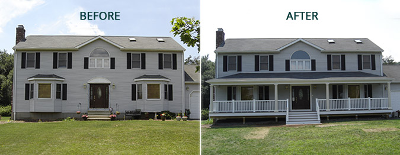Welcome back to me! I was out for the last few weeks due to a combination of work and getting post-surgery treatment for my thyroid.
Today, I am going to go over some differences and similarities between rehabbing a property to flip it and rehabbing a property to retain as a rental.

Compare & Contrast
What is your “Plan A” for a property in a given situation? That is probably an easy question to answer if you only flip properties or if you only buy and hold them as rentals. Some investors do both.
Ultimately, you should already know what you want to do with your property. Then work on a “Plan B” and “Plan C”, just in case your Plan A doesn’t work out.
Compare
Whether rehabbing a property as a flip or as a rental, there are a lot of things that you would do the same in either case. Getting the main home systems in working order, such as plumbing, electrical, roof, HVAC, etc. You need these systems in working order and, with the exception of fixtures, don’t need a lot of variation between the two.
Structures should be stable, rooms may need to be added, and/or rearranged.
Contrast
Rentals
When rehabbing rentals, you want to keep things functional and not too expensive. Depending on the comparable quality of the neighborhood, you may go utilize a higher-end product in a higher-end neighborhood than you would in a lower-end neighborhood.
Especially if you have multiple rentals, you want to go for consistency to normalize your costs. Have a paint scheme, flooring style/type, appliance set, and plumbing & lighting fixtures as a standard so that time will not have to be wasted on trying to decide on colors & styles during rehab and turnovers. Your contractors or turnover specialists should already know what to use.
Flips
When flipping, you are attempting to renovate the property to a standard that will make someone want to buy the home to live in. With that in mind, you want to add finishing touches to a flip that you would not consider for a rental. This could include things like upgraded appliances, fancier light fixtures, premium paint schemes, and so on.
All of this assumes that you have the budget to achieve this and still make money on it.
I would like to know more about my readers. If you could spare about 2 minutes of your time, please take a survey to tell me what you like about the blog. Just click here to take the survey.
Plans B and C
I mentioned “Plan B” and “Plan C” above, so I just wanted to touch on that before wrapping things up. You should always have an exit plan. Or two. If you are planning to flip, be ready to rent or owner-finance. If you and planning to rent, be prepared to sell.
This is kind of second nature to me coming from the oil and gas industry. It has a direct physical basis, but can be applied metaphorically to pretty much anything.
Having an exit plan means not being stuck in harm’s way. When working on a drilling rig, this has life or death implications. Never put yourself in a corner where you cannot get out of the way of something.
I learned this the hard way when loading eleven and three-quarter-inch casing onto a boat when I first started out in the industry working as a roustabout.
For those of you who don’t know what casing is, it is the large-diameter pipe used to keep the wellbore pressure in and the formation pressures out when drilling and producing a well. Each forty-foot joint weighs approximately two thousand four hundred pounds.
The crane was set up to pick up four joints of casing at a time. Additionally, we were short-handed, so I would hook up the casing on the dock, then jump to the boat to help position it on the deck of the boat so it would stack properly for the ride out to the rig.
On one of the lifts, by the time I got onto the deck of the boat, the pipe was coming towards me and I did not want to be under ten thousand pounds of steel. I attempted to get outside the range of the swing of the crane, but realized that I had no more deck because we were loading onto the stern now.
I dropped down onto the deck, sitting, so that at least if the load dropped, the railing would help stop it from crushing me. I believe that maneuver startled the crane operator and he stopped the crane rotation, thus setting the load swinging like a pendulum. He immediately noticed this and started to drop the load as it got over the deck, but the casing had started to swing back towards the stern, where I was sitting.
The casing made contact with my left shoulder and chest. Luckily, it was only enough to bring out purple, yellow, and green bruises on me the next day, but no permanent damage.
The moral of the story? Have an exit plan that you can execute on.
And, as always, let me know what you think in the comments. Ask questions, tell your story.
If you like my posts, please share them with others and subscribe to this blog.
















